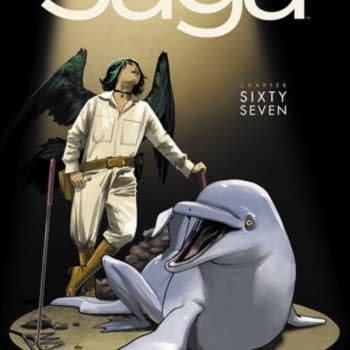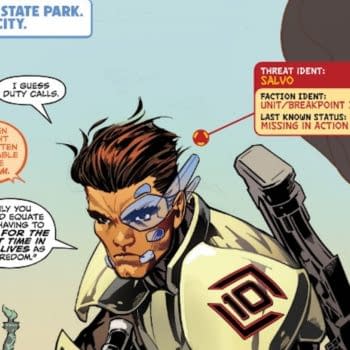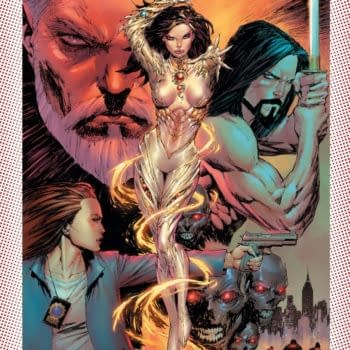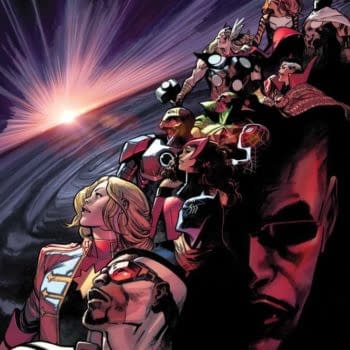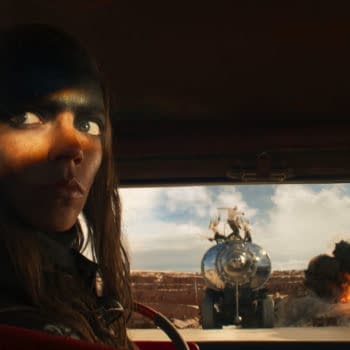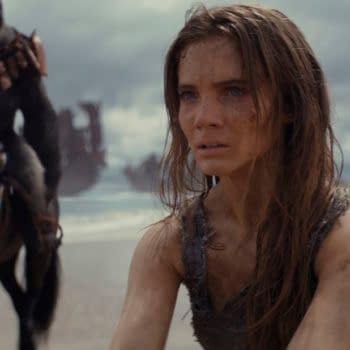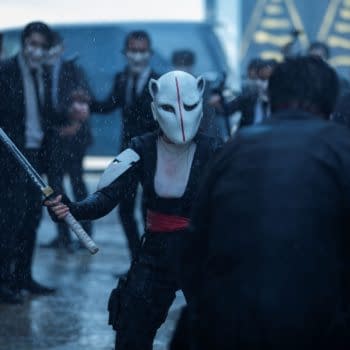Posted in: Movies | Tagged: doctor who
Five Thoughts Each About The Two Newly Found Doctor Who Episodes
Philip Sandifer writes for Bleeding Cool;
The big news today in Doctor Who is that two previously missing episodes have been found – Part Three of the Season Three opener Galaxy Four, starring William Hartnell, and Part Two of Patrick Troughton's third story, The Underwater Menace. The former had no surviving episodes, whereas the latter had its third episode, which was, until today, the earliest existing episode of Patrick Troughton.
These are not episodes that made anybody's top ten list of wished for discoveries. But they are two extremely interesting finds that have the potential to tell us some really new and interesting things about the era they're from. Indeed, for fans more interested in learning about the show in the 1960s than in reconstructing their own (or more often someone else's) childhood, these are two of the best finds imaginable. Here's ten things to look for as these filter out to wide release.
Galaxy Four Part 3
1. Rill Of The Chase
Galaxy Four uses one of those conceits that are so obvious that everyone just assumes Doctor Who has done it. The beautiful female Drahvins turn out to be the villains of the piece, whereas the monstrous Rills are sympathetic good guys. The Rills, however, are among the least documented monsters in Doctor Who. This story had particularly little visual material surviving, and for years we didn't even have any images of the Rills. Eventually one photograph surfaced, and by all appearances they were pretty spectacular designs. Now we're going to get full video of a monster that, for a long time, we knew next to nothing about. Are they one of the great lost designs of Doctor Who? Are they complete rubbish?
2) He's Always A Woman To Me
Peter Purves played Steven Taylor, the second male companion that William Hartnell had. Purves is an interesting actor. He's better known these days for his stint as a Blue Peter host, in part because only seventeen episodes that he appeared in as Steven exist. He held the second male lead during the period where William Hartnell's health was in decline, and was frequently forced to step up and anchor episodes when Hartnell was unable to. As a result, his character is something of a chameleon.
This is his second full story, and the script was first written before he joined the cast. The bulk of his role in this consists of lines originally written for Jacqueline Hill, who played Barbara Wright in the first two seasons of Doctor Who. It is, in other words, the first of many times that Peter Purves is called on to do something different from what his role is expected to be. How does he cope?
3. The Doctor Needs A Doctor
Speaking of Hartnell's fading health, this season is the one over which it really takes a turn for the worse. This was actually filmed at the end of Season Two, and featured a de facto new producer, John Wiles. Hartnell got on terribly with Wiles, hated the scripts, and was nearly fired from the show in the course of this story. So how is Hartnell in it? This is either one of the last stories where he was in really good health or one of the first in which his failing health becomes visible. It's also the second story he did featuring none of his original supporting cast, and, as mentioned, the first under a producer he didn't get along with. Lots of people are going to be very interested in seeing the nuances of his performance here and reading tea leaves from them.
4. Not The Next Daleks
On top of the Rills, Galaxy Four has two other interesting creatures to get proper glimpses of. First are the robotic servants, the Chumblies. Apparently designed with the genuine belief that they could be the next Daleks, if clearly not named with that belief, the Chumblies are unmistakably 1960s designs, if not unmistakably 1960s classics. Little round robots that make some particularly interesting and unusual sound effects, proper footage of these guys is a nice little treat.
Also interesting are the Drahvins. We had a few minutes of episode one of this story already that largely featured the Drahvins, who are identical looking blonde warrior women with beehives and ray guns. There's nothing particularly remarkable about them, except that Steven Moffat happens to have plucked them from obscurity to feature in his massive Alliance swirling around Stonehenge in The Pandorica Opens. They only get an off-handed mention on a list of foes there, and were thrown in as particularly obscure fan service. I suspect a lot more people are going to get that joke now.
5. Nostalgia Wasn't What It Used To Be
More prosaically, Galaxy Four is interesting as the first time that Doctor Who gave up on trying to do anything new and just went for the classics. The director, Derek Martinus, is one of the more acclaimed directors of the black and white era, but of his 28 episodes directed, fourteen were previously missing. Now that's down to thirteen, and we get to see what he was able to do with Doctor Who at what was, for the 1960s, its most bog-standard. In future years going back and attempting to relive past glories would become one of the standard things Doctor Who does – indeed, it still does more than one story a season that works like that. This is the first such nostalgia piece in Doctor Who, and an opportunity to watch the early days of the show reflect upon themselves.
The Underwater Menace Part 2
1. Torture Porn, Doctor Who Style
The opening of this episode actually contains things we have clips of. Polly, the female companion of the era, is held down by evil surgeons who advance on her with a hypodermic needle to sedate her so that they can surgically change her into a fish person. The clips we have exist because the scene was too disturbing and was censored in Australia. But it's still only about half the scene, and it's impossible to tell how the scene is paced and shot. Flickering lights, evil doctors, and a fear of surgery sound like they could add up to one of the most disturbing scenes of the 1960s, or indeed of any other era.
2. The Phantom Menace
The Underwater Menace, based on the reputation of its third episode, is not well loved. A mixture of ludicrous overacting, a fairly lame plot, and some incomprehensible visuals involving people in fish costumes doing ballet have left this as one of the most hated stories in Doctor Who. Interestingly, though, this is also where the bulk of the budget for the fourth season went. This was a staggeringly expensive story, leading plenty of people to wonder what, if anything, the production team was thinking.
And this is an interesting question. This is Patrick Troughton's third story, and comes from a period where his Doctor was still being established. The newly found episode is only his twelfth episode in the part, and nobody had ever done what he was doing before; he replaced the lead actor on a popular show by playing a completely different version of the same man. On top of that the tone of the show was in transition. Starting with the next story it would move towards a familiar model of monsters attacking various isolated outposts. But here the show is still clearly in a mode of "exploring weird places" inherited from the early seasons. And it's clear that Atlantis is both very weird and very expensively made. In short, we have 25 minutes more in which to try to figure out what was going on with this story. They're probably not going to get people to change their minds and declare this story to be brilliant, but the fact remains that there's a lot to learn about this one.
4. Just One Small Question
For all that this story has a deeply poor reputation, it has one scene that fans of Patrick Troughton's Doctor will be salivating to see. Troughton's Doctor is known for being particularly mercurial. He's both less prone to outraged and defiant moralizing than many of the other Doctors and more prone to manipulating and cajoling enemies. He's often characterized as lurking around the edges of a story until the end, as opposed to being at the center of it.
In the scene in question, he's meeting the story's villain, the mad scientist Professor Zaroff (about whom more later). Zaroff is revealing his plan, and as he does the Doctor slowly realizes that Zaroff is a madman and that his plan will destroy the planet. Zaroff confirms that he knows this, and the Doctor, stunned, quietly asks "Just one small question, Professor. Why do you want to blow up the world?" It's a triumph of acting. It's the first time Troughton is up against a really credible guest star, and instead of overacting and trying to steal the scene, he plays it very quietly and timidly, defining his Doctor in the process. This two minute scene alone is one of the best missing episode finds available.
4. Furst Among Equals
Speaking of which, Joseph Furst. Furst is quite a good actor, but his performance in this story is widely ridiculed as the single most over the top mad scientist in all of Doctor Who. This is an impressive title to seize, but seize it he does, based largely on his inspired rendition of the line "nothing in the world can stop me now" at the end of the previously-existing Episode Three. Of all of the things that mystify people about this story (and as you can see there are a lot of them), the question of what Furst was thinking and whether he turned in an appalling piece of overacting or a sublimely funny parody is one of the most pressing.
5. That Wet Suit
One of the most interesting things about it is that it's the first story to feature Frazer Hines as a regular companion. He debuted as a background character in the previous story, and then unexpectedly joined the TARDIS crew at the end. His character, Jamie McCrimmon, would end up being with Troughton until the end of his tenure, and is a popular and beloved character. Here we get to see him bedding in, and get to see more of how the show resolved the tension of having two characters in the "male action companion" role. One of them, Michael Craze's Ben Jackson, would be dropped from the series in just three stories' time. Seeing how the early days of that transition unfolded is going to be interesting. (This is also the story where renowned playwright Joe Orton is known to have written admiringly in his diary of Frazer Hines's legs. Hines spends much of the story in a wetsuit, and Orton's reaction is pretty understandable.)
Phil Sandifer is a scholar and blogger at TARDIS Eruditorum. His book collecting his blog posts on the Hartnell era is available on Amazon.com.









